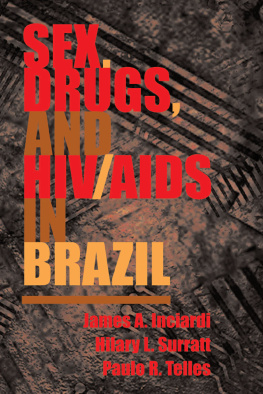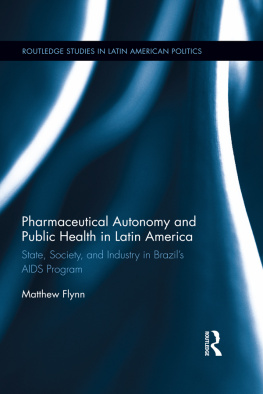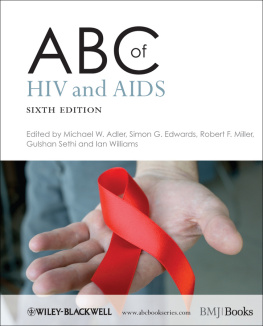First published 2000 by Westview Press
Published 2018 by Routledge
711 Third Avenue, New York, NY 10017, USA
2 Park Square, Milton Park, Abingdon, Oxon OX14 4RN
Routledge is an imprint of the Taylor & Francis Group, an informa business
Copyright 2000 Taylor & Francis
This research was supported by PHS Grant # UO1DAO8510, HIV/AIDS Community Outreach in Rio de Janeiro, Brazil, from the National Institute on Drug Abuse. The opinions expressed are those of the authors.
All rights reserved. No part of this book may be reprinted or reproduced or utilised in any form or by any electronic, mechanical, or other means, now known or hereafter invented, including photocopying and recording, or in any information storage or retrieval system, without permission in writing from the publishers.
Notice:
Product or corporate names may be trademarks or registered trademarks, and are used only for identification and explanation without intent to infringe.
Library of Congress Cataloging-in-Publication Data
Inciardi, James A.
Favela and asfalto : sex, drugs, and HIV/AIDS in Brazil / James A. Inciardi, Hilary L. Surratt, Paulo R. Telles.
p. cm.
Includes bibliographical references and index.
ISBN 0-8133-3424-1 (pbk. : alk. paper)
1. AIDS (Disease)Brazil. 2. AIDS (Disease)BrazilRio de Janiero. 3. AIDS (Disease)BrazilPrevention. 4. AIDS (Disease)BrazilRio de JanieroPrevention. 5. Urban poorHealth and hygieneBrazil. I. Surratt, Hilary L. II. Telles, Paulo R. III. Title
RA644.A25 I496 2000
362.196979200981dc21
00-043784
ISBN 13: 978-0-8133-3424-0 (pbk)
Since its settlement by the Portuguese in the 16th century, Brazil has provided ceaseless fascination for people in other parts of the world. Brazil has gold, rubber, and coffee. During and after World War II it was a place of refuge, and more recently it boasts the sights and sounds of the worlds fifth largest nation. And then there are the Brazilians themselves, who enjoy one of the richest musical cultures in the world. Clearly the most sophisticated popular music across the globe, Brazilian world beat is a sensuous mlange of African, Indian, European, and American influences. Nightly in any major city, one can find internationally known jazz artists, regional musicians specializing in native rhythms, and both world-class and local dancers executing the complex moves of the bossa nova, lambada, pagode, and of course, the samba. And not to be forgotten is Antonio Carlos Jobims The Girl from Ipanema, considered by the music industry to be the most popular song ever recorded.
The geography of Brazil also is unique, diverse, and captivating. With the exception of Chile and Ecuador, Brazil borders every country in South America and occupies almost half the continent. There are the coastal mountain ranges, the vast wetlands of the Pantanal, and the lush Amazon basin and rain forest.
But despite its beauty and richness, Brazil faces many problems. For example, the country experiences major environmental challenges, which place much of its vast natural wealth under continuous threat. There is pollution and poaching in the Pantanal, where upwards of two million animals are killed each year. There is the exploitation and destruction of the Amazon. This large, complex, and fragile ecosystemcomprising one-tenth of the Earths plant and animal species, producing one-fifth of the worlds oxygen, and containing one-fifth of the planets fresh wateris endangered through the clearing of rain forests, stripping of entire ecosystems for mines, and damming of rivers. Among the people of Brazil there is extensive poverty and inequality, exacerbated by the countrys weak and uneven economic situation. Moreover, the geography, climate, economy, and poverty combine to place large segments of the population at risk for a wide range of viral, bacterial, and fungal infections and diseasestyphus, yellow fever, tuberculosis, hepatitis, intestinal worms, dengue, Chagas disease, filariasis, and schistosomiasis to name but a few.
What few people outside of Brazil realize, furthermore, and what even most Brazilians are unaware of, is the extent to which HIV and AIDS are a problem in this great South American nation. In fact, at the closing of the millennium and moving into the twenty-first century, Brazil ranked second only to the United States in the number of reported cases of AIDS. As in the U.S., AIDS in Brazil was initially believed to be a disease of middle-class gay men. But as the epidemic expanded and the number of cases among women, heterosexual men, injection drug users, and children increased, efforts were mobilized by the countrys Ministry of Health to curtail the spread of the disease. But because of Brazils extensive poverty and inequality, its fragile economic situation, and limited network of health services, the scarce prevention/intervention resources targeted only the most visible at risk populationsgay men, sailors, prostitutes, and street children. Virtually forgotten were Brazils hidden drug users, as well as the tens of millions of individuals living in the countrys thousands of favelas or shantytowns, which are a characteristic part of almost every Brazilian city. Also forgotten were the scores of indigent residents of the asfalto, the asphalt city, the low-income/high-crime areas of urban centers beyond the slopes of the favelas.
Within the context of these opening remarks Sex, Drugs, and HIV/AIDS in Brazil examines the emergence of AIDS as a global epidemic and, particularly in Brazil, its linkages to drug use and the sexual culture, and its epidemiology in such populations as cocaine users, street children, and male transvestite prostitutes. Special attention, furthermore, is focused on an HIV/AIDS community outreach program established in Rio de Janeiro, which represented the first such prevention/intervention effort in all of Brazil targeting indigent cocaine users. This six-year initiative was funded by the Community Research Branch of the U.S. National Institute on Drug Abuse, and carried out by the authors of this book through collaborative arrangements between the State University of Rio de Janeiro, the University of Miami School of Medicine, and the University of Delaware.
James A. Inciardi
Hilary L. Surratt
Paulo R. Telles











